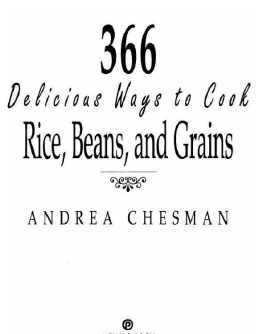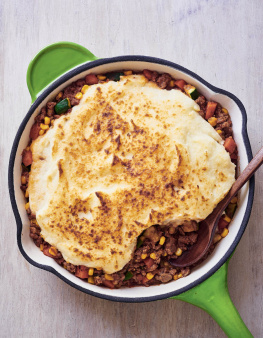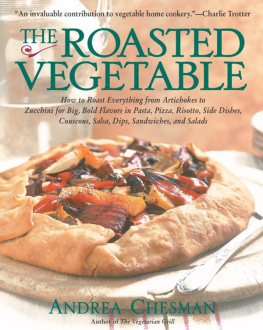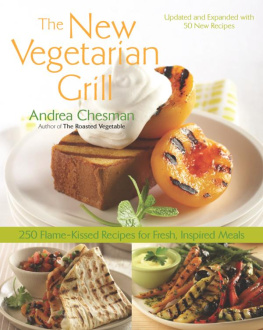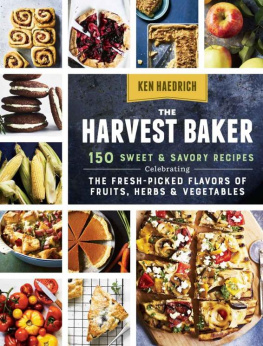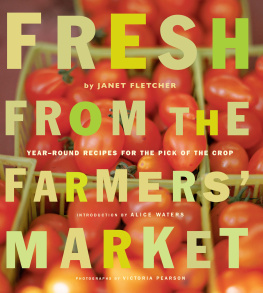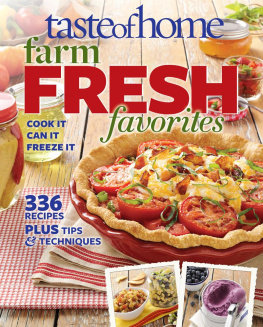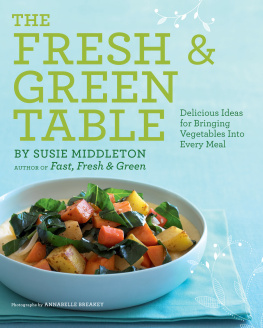SERVING UP THE HARVEST
Serving Up the Harvest
Andrea Chesman

Illustrations by Margaret Chodos-Irvine

The mission of Storey Publishing is to serve our customers by
publishing practical information that encourages
personal independence in harmony with the environment.
Edited by Dianne Cutillo and Andrea Dodge
Art direction by Kent Lew and Cynthia N. McFarland
Cover design by Kent Lew
Cover illustration Jane Davies
Cover author photograph Natalie Stultz
Interior illustrations Margaret Chodos-Irvine
Text design by Cynthia N. McFarland
Text production by Jessica Armstrong and Jennifer Jepson Smith
2005, 2007 by Andrea Chesman
Previously published as The Garden-Fresh Vegetable Cookbook in a hardcover edition in 2005
All rights reserved. No part of this book may be reproduced without written permission from the publisher, except by a reviewer who may quote brief passages or reproduce illustrations in a review with appropriate credits; nor may any part of this book be reproduced, stored in a retrieval system, or transmitted in any form or by any means electronic, mechanical, photocopying, recording, or other without written permission from the publisher.
The information in this book is true and complete to the best of our knowledge. All recommendations are made without guarantee on the part of the author or Storey Publishing. The author and publisher disclaim any liability in connection with the use of this information. For additional information please contact Storey Publishing, 210 MASS MoCA Way, North Adams, MA 01247.
Storey books are available for special premium and promotional uses and for customized editions. For further information, please call 1-800-793-9396.
Printed in the United States by R.R. Donnelley
10 9 8 7 6 5 4 3 2
LIBRARY OF CONGRESS CATALOGING-IN-PUBLICATION DATA
Chesman, Andrea.
[Garden-fresh vegetable cookbook]
Serving up the harvest / Andrea Chesman.
p. cm.
Previously published as: The garden-fresh vegetable cookbook in a hardcover
edition in 2005.
Includes index.
ISBN 978-1-58017-663-7 (pbk.: alk. paper)
1. Cookery (Vegetables) I. Title.
TX801.C438 2007
641.651 dc22
2007003167
To Richard, Rory, and Sam, always

PREFACE
THERE ARE TWO TYPES OF GARDENERS, I think. There are gardeners who cook, and there are cooks who garden. I happen to be a cook who gardens. You can recognize my type by my less-than-photogenic garden, my casual attitude toward weeds, my hatred of thinning (throwing away good food!). I spend winter evenings with cookbooks, not with treatises on soil building. I am unlikely to plant vegetables that are reluctant to grow in my northern garden just to prove that I can. I have never grown a prizewinning anything. I have never even set aside space in my garden for a carving pumpkin.
Dont get me wrong. I have tremendous respect for those who put gardening first. Their gardens are gorgeous! These gardeners are often so adept in the outside world that they are capable of building beautiful trellises and amazing bean tepees. They never fail to properly put the garden to bed in the fall, and their peas are inevitably two weeks earlier than mine. They often lead the way with planting new varieties or experimenting with old heirloom varieties. They save seeds, and they have opinions on compost.
But heres the big difference. Cooks who garden are thrilled by the harvest. We believe every overflowing basket of vegetables is an opportunity for a crispy fresh salad, a fragrant harvest stew, a terrific new pasta sauce. On the other hand, gardeners who cook will spend hours in the garden, making everything look perfect, and then find themselves stricken with guilt. Oh no, they suddenly realize, someone has to cook all those vegetables!
Of course, not everyone who enjoys vegetables has the chance or the inclination to grow her own vegetables. Some of my very best friends buy all of their vegetables. And why not, with farmers markets, produce stands, and CSA (Community Supported Agriculture) farms distributing wonderful fresh produce to rural, suburban, and urban markets? Once these shoppers get their vegetables home, however, there is still the problem of what to do with them.
Well, not to worry. Cooks like me have fun in the kitchen, making recipes that are quick, easy, and delicious and honor the vegetables we have worked so hard to bring into our kitchens.
But whether you are a gardener who cooks or a cook who gardens, we undoubtedly share the thrill that comes with the start of the gardening season. My garden lies uphill from my house on a plot that has been a garden as far back as anyone remembers, which is more than 50 years. Each spring, the snow melts from the garden plot early and, before my lawn is snow-free, garlic shoots poke through the dark soil of the raised beds. Within a few weeks, I plant peas and spinach, then more spring greens. I begin to harvest fresh chives, oregano, and thyme to enhance my cooking. Then it is asparagus season, and the harvest has truly begun.
Because I live in the North (Zone 4), my gardening season is limited. I have often been able to get two sowings of peas as well as green beans out of my garden, but some years I have very few tomatoes. I have never been successful with peppers or eggplant. Although this cookbook follows the harvest, the particulars of my harvest seasons may be different from yours. I know that my brother in Alabama harvests his first tomatoes when I am reveling in the first asparagus. Still, he gets in a crop of spring greens, just like I do, though the month of the harvest is different, and my season lasts longer than his. So I have organized this book by season, and within each season, I have organized the vegetables alphabetically, since variations in number of days to harvest various vegetables make it impossible to predict the exact order of the harvest. What is possible to predict is that you wont find certain vegetables growing together, and you wont find recipes for unlikely combinations of vegetables in this cookbook. No stews with winter squash and peas, no green bean and asparagus salads.
There are some flaws to this system. Take carrots. You could easily plant short-season carrots, harvest them young, and enjoy in the summer. Or you could plant a long-season variety well suited to long-term storage. So are carrots a summer or fall vegetable? Well, Ive chosen to put them with other fall storage crops, because I dont usually cook with summer carrots. Those early carrots are just perfect as they are. Carrots from the root cellar can and should be enhanced by cooking. If you cant find a vegetable in its proper season, look for it in the index.
What Ive tried to accomplish with my seasonal organization is to present simple recipes that feature in-season vegetables, recipes that let the unique flavor and texture of each vegetable take center stage. I hope you enjoy them. 
ACKNOWLEDGMENTS
There is no way this book could have been written without the help of all the farmers who supply my local farmers market and food co-op with delicious vegetables. I am simply too limited as a gardener to grow enough vegetables and enough variety of vegetables to provide myself with all the produce needed for the recipe tests that went into this book. My special thanks to Will and Judy Stevens of Golden Russet Farm in Shoreham, Vermont, and Marion Pollack and Marjorie Sussman of Orb Weaver Farm in Monkton, Vermont, for veggies, inspirations, and recipes. My thanks also to all the folks at the Middlebury Natural Foods Co-op for keeping such a terrific store going, and for inspiration, conversation, and making my regular shopping trips so much fun.
Next page

